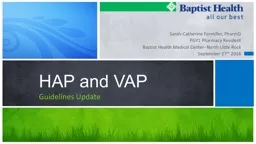

PharmD PGY1 Pharmacy Resident Baptist Health Medical Center North Little Rock September 27 th 2016 HAP and VAP Guidelines Update Objectives Outline Major differences introduced in the 2016 guidelines ID: 689419
Download Presentation The PPT/PDF document "Sarah-Catherine Formiller," is the property of its rightful owner. Permission is granted to download and print the materials on this web site for personal, non-commercial use only, and to display it on your personal computer provided you do not modify the materials and that you retain all copyright notices contained in the materials. By downloading content from our website, you accept the terms of this agreement.
Slide1
Sarah-Catherine Formiller, PharmDPGY1 Pharmacy Resident Baptist Health Medical Center- North Little Rock September 27th 2016
HAP and VAPGuidelines UpdateSlide2Slide3
ObjectivesSlide4
Outline
Major differences introduced in the 2016 guidelines
Empiric treatment of VAP and HAP
Antimicrobial de-escalation and discontinuation
Practice patient caseSlide5
Additional recommendations not covered
Diagnosis recommendations
Invasive vs. noninvasive
Quantitative vs. qualitative
Using clinical criteria to diagnose HAP/VAP
PCT, sTERM-1, CRP,
CPIS
Inhaled Antibiotic
Therapy
Pathogen specific therapySlide6
Major DifferencesSlide7
Major Differences in New Guidelines
Removal
of the concept of healthcare-associated pneumonia (HCAP)
Recommendation that each hospital generate
antibiograms
to base antimicrobial choice
upon
Shorter duration of therapy independent of microbial etiologySlide8
Antibiograms
Empiric treatment
regimens
based
on
antibiograms
Minimize
patient harm and
exposure
Reduce the development of antibiotic
resistance
Decrease the unnecessary use of dual gram-negative and
empiric MRSA treatment
Specific
to
VAP
populations
(ICU)
Specific to HAP
populationsSlide9
Empiric TreatmentSlide10
Risk Factors for MDR Pathogens
VAP
HAP
MRSA or
P.
aeruginosa
Prior IV antibiotic use within 90 day
Septic shock at time of VAP
ARDS prior to the occurrence
of
VAP
5 or more days of hospitalization prior to the occurrence of VAP
Acute renal replacement therapy prior to the occurrence of VAPSlide11
Empiric Therapy for VAP
S.
aureus
, P.
aeruginosa
and other gram-negative bacilli
MRSA coverage if
Risk factors
for antimicrobial resistance
Units where >10%-20% of
S.
aureus
isolates are methicillin resistant
Units where the prevalence of MRSA is not known
MSSA coverage only, if
Without
risk factors
for antimicrobial resistance
ICUs where <10%-20% of
S.
aureus
isolates are methicillin resistant Slide12
Empiric
Antipseudomonal
Coverage VAP
Double Coverage
Risk factors
for resistance
Units where
>10% of gram-negative isolates are resistant to an agent being considered for monotherapy
Susceptibility rates for ICU not available
Monotherapy
No
risk factors
for resistance
ICU’s where
≤
10% of gram-negative isolates are resistant to the agent being considered for monotherapy
Avoid aminoglycosides
or
colistin
when
possibleSlide13
Empiric Therapy for HAP
S.
aureus
, P.
aeruginosa
and other gram-negative bacilli
MRSA coverage if
IV
antibiotics in last 90
days
Unit where >20% of
S.
aureus
isolates are methicillin resistant
Prevalence
of MRSA is not known
High risk for mortality
MSSA coverage if
Empiric treatment and have no
risk factors
for MRSA
Not at high risk of mortalitySlide14
Empiric
Antipseudomonal
Coverage HAP
Double Coverage
Risk factors
for
Pseudomonas
or other gram-negative infection
IV antibiotics in the last 90
days
Structural lung disease
High risk of mortality
Monotherapy
All other patients with HAP who are being treated empirically
Do not use aminoglycoside as sole
antipseudomonal
agentSlide15
Definitive TreatmentSlide16
Monotherapy vs. Combination
therapy
for P. aeruginosa
Monotherapy
Not in septic shock or at high risk of death
Susceptibility results are known
Combination therapy
Septic shock
High risk of death when the results of antibiotic susceptibility testing are
known
Recommend against aminoglycoside monotherapySlide17
Duration of Therapy
7 day course of antimicrobial therapy
Discontinue based on PCT levels + clinical criteria vs. clinical criteria alone
De-escalation of therapy recommended rather than fixed therapySlide18
Practice Patient
CaseSlide19
Practice Patient Case
MD is a 69
yo
WM admitted to the hospital for a 1 week history of cough and dyspnea. Review of his symptoms reveals fever, chills, productive cough, and dyspnea. PMH includes T2DM, HTN, COPD, and glaucoma. Patient was admitted 1 month ago with sepsis due to a UTI and received IV antibiotics. The physician ask you for recommendations on empiric therapy for this patient. Patient was admitted to a unit where the susceptibility rates are unknown.Slide20
What do you suggest for empiric coverage?
Vancomycin
+
Zosyn
+
Cefepime
Vancomycin
+
Cefepime
+
Gentamicin
Linezolid +
Ceftazidime
Azithromycin + CeftriaxoneSlide21
Definitive therapy
Patient is clinically improving and cultures have resulted.
Pseudomonas
aeruginosa
Pansensitive
Physician narrows therapy based on the susceptibility results which you determine to be appropriate. Slide22
How many days of ABX does this
pt
need?
14 days
5 days
7 day
3 daysSlide23
Summary
HCAP is no longer a classification of pneumonia
Empiric therapy of VAP and HAP should be driven by local
antibiograms
Empiric therapy should be individualized based on RF for MDR organisms
Antibiotic de-escalation is recommended
Duration of therapy is 7 days if clinically improvingSlide24
Reference
Kalil, A. C.,
Metersky
, M. L., Klompas, M., et al (2016). Management of Adults With Hospital-acquired and Ventilator-associated Pneumonia: 2016 Clinical Practice Guidelines by the Infectious Diseases Society of America and the American Thoracic Society.
Clin
Infect Dis. Clinical Infectious Diseases, 63(5). Slide25
Sarah-Catherine Formiller, PharmDPGY1 Pharmacy Resident Baptist Health Medical Center- North Little Rock September 27th 2016
HAP and VAPGuidelines Update